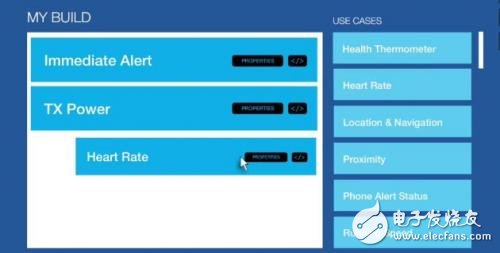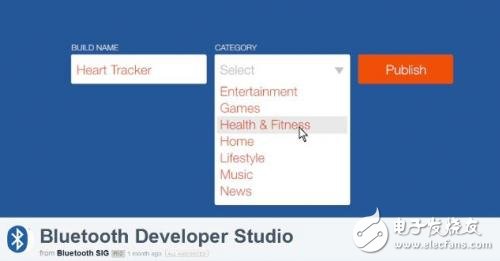do you know? In the Internet of Things (IoT) generation, the process of designing our products will be very different from the previous ones. Perhaps you have heard that this will be an era of all things intelligence, all hardware can have intelligence, your clothes, cups, coffee machines can be given the ability to calculate and the ability to interact with people. The IoT market we are facing will not be a market where a single product is enough to detonate, but will be a market for The Long Tail.
Long tail theory? Does this have a relationship with smart hardware development? Yes, a few days ago, Gao Wensen, technical manager of the Bluetooth SIG development project, said that the development of intelligent hardware in the IoT market means that the development of intelligent hardware is no longer a time when the product plan has gone all over the world. The emergence of power consumption Bluetooth, the realization of the Internet hardware era of the Bluetooth hardware market will be a long tail market, a few years ago, everyone mentioned Bluetooth hardware development, think of Bluetooth headset, almost a solution can be copied in countless Chinese factories. Now Bluetooth has encountered a wide IoT opportunity. The smart connected device based on Bluetooth connection technology may be a toothbrush, heart rate monitor, door lock, light bulb and other equipment. The development plan will be very innovative and different, covering the field. It will vary widely. The only thing that remains unchanged is that you will leave us with less development time. Our team will also join a lot of “out-of-door†designers, who may not be familiar with electronic design, but at the same time are experts in their field. In common, we all want to quickly develop innovative, intelligent hardware products that meet market needs.
Talking about business, then? What do you do if you are developing a smart hardware based on Bluetooth connectivity technology? Check Paper on one page, learn from basic protocols? To know that the designer's precious time should be left to the development and implementation of the function, let alone leave us not much time. Of course, if you are a "Bluetooth", you are already familiar with the latest announcements, earlier announcements, and various Bluetooth profiles, or you want to rely on your own strength to eat a thick stack of references without worrying about development time. OK, please ignore the content below.
Or would you, look for a manufacturer's reference design or development kit support? This is a good way. Today, we don't want to deny this kind of conventional good method. We want to provide a new option that can speed up development, and this choice can be superimposed on the basis of the manufacturer's reference design or development kit support. Above, and shorten development time again.
Ok, there’s a bit more in front, so let’s talk about shortening development time. The good method mentioned here is the Bluetooth Technology Studio development kit launched by the Bluetooth Technology Alliance for the development of IoT products. According to the official Bluetooth Alliance, "Bluetooth Developer Studio" can effectively reduce Bluetooth learning time by up to 50%. Feedback from novice users and experienced Bluetooth developers shows that "Bluetooth Developer Studio" is able to reduce Bluetooth development time by up to 70%.
Shortened by 70%? How is it done? In short, by providing a "code instance", developers can find an instance template in the "development library" that fits the general idea of ​​their own development project, and quickly create their own project by simply dragging and dropping (Figure 1). Based on this, the development prototype can be generated. The designer can further use the development kit for prototyping and interoperability testing (including virtual testing). The tool also directly supports the resolution of each Bluetooth original manufacturer (Bluetooth chip and module supplier). The program can automatically generate the code file after selecting the specific chip/module, and finally import it into the original development software or development board for further functional development and other steps, and transform the design directly into the product. Gao Wensen demonstrated and exemplified, for example: I want to design a "smart coffee machine", have a development board and hope to complete the above software. I can retrieve another guy's smart coffee machine project in the toolkit, drag it over with the mouse, modify and define some of the variables I need, and get a prototype in about 15 minutes. Then based on the prototype, further select the original program. For example, if you want to use Nordic's board, Bluetooth Developer Studio will automatically generate the code suitable for Nordic. I can put the code directly on the Nordic development board. Of course, the development kit itself is a graphical interface, and operation and generation are very simple. Developers can also easily get tutorials and are easy to learn.

In Figure 1, the developer finds the instance template in the "development library" that meets the needs of his project, and quickly creates his own project by simple drag and drop.
There are so many manufacturers to develop kits, why use the Bluetooth Alliance toolkit? Of course, first of all it is completely free to download (whether it is the current Beta version or the future official version). Secondly, this time the toolkit released by the Alliance mainly wants to fill a gap, which is based on the development and debugging of the Generic Attribute Profile (GATT). The high manager also said that unlike the original kit, the toolkit released by the alliance is hoping to provide more support for the Bluetooth protocol layer. Before using the original kit for development, designers often need to define the original custom profile. You need to understand a lot of Profile documents. Now you can omit this step while downloading the instance, or the designer can already A new application is created based on the configuration file, thereby greatly saving development time. Of course, your profile can also be published on the platform for more people to use.
From a compilation point of view, the compilation function of this tool is also an enhancement to some aspects of the original compiler. You can generate code based on an original development board in the tool and then import it into the original development tool for further performance. Development, UI development, etc., and then use the original development tools to compile the code and finally import the development board, such a process can save a lot of development time. Of course, this tool can also perform virtual tests such as prototyping and interoperability verification on the basis of rapid prototyping. This is also in line with the fast iteration concept that is currently popular in the development world, and it is necessary to quickly turn the design concept into a product for verification, which also proposes new ideas for tools and development processes.
In addition, this tool can also facilitate the selection of different manufacturers' boards. It can quickly generate codes based on different boards of different manufacturers after prototyping, saving the selection time. Of course, this tool has great guidance for beginners of Bluetooth design. The Bluetooth Alliance hopes to reduce the Bluetooth development threshold through the Bluetooth Developer Studio tool, and at the same time accelerate the development by designing templates and improve the development quality.
Having talked so much, the final Xiaobian also wants to add a sentence. As a designer, are you not curious about the development of others? Some examples in the design library are based on the application and reference design uploaded by the developer, which you can learn from or optimize.
It sounds like the design library is very powerful, what are there? Since it is an open source platform, the most attractive part of the "design library" is the "code instance" template. According to the high manager, there are reference designs from the original factory in the design library, as well as designs uploaded by the developers themselves. Some applications are very extensive and form similar standards. They will be labeled "Adopted", meaning that this is widely used by the Bluetooth Alliance. Some are based on designer uploads and have their own uniqueness. For example: heartbeat design, if everyone basically agrees that the heartbeat should have 1, 2, 3 specifications, the vote passed, this is called "Adopted". There may be some manufacturers who want to add 5 and 6, which will be his own customization. At present, there are more than 20 categories of development libraries (Figure 2), covering all kinds of intelligent hardware such as wearable products, smart homes, and health products. Since it is only a beta version and is completely open source, I believe this design library will be in the future. Will continue to expand and expand.

Figure 2 shows that there are more than twenty categories in the current development library. The prototypes built by the designers themselves can also be classified and released in the tool.
Shenzhen Aierbaita Technology Co., Ltd. , https://www.aierbaitavape.com
